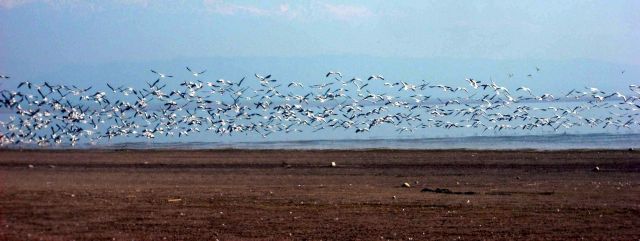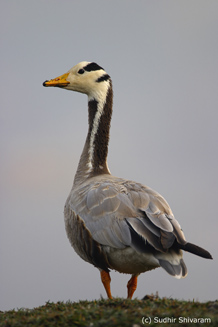Pong Dam (Himachal Pradesh): Over 27,000 bar-headed geese, the world’s highest-altitude migrant bird species, are “holidaying” in Himachal Pradesh’s Pong Dam wetlands along with around 100,000 other birds of 60 migratory and local species.
A wildlife official said the influx of the bar-headed geese at Pong Dam has increased enormously after a gap of two years.
“As per our initial estimates, the number of bar-headed goose could be more than 27,000,” said Assistant Conservator of Forests (Wildlife) D.S. Dadwal.
He said besides the bar-headed goose, the other prominent species are the common coot, northern pintail, common pochard, tufted pochard, red-crested pochard, common teal, little cormorant, great-crested grebe and greylag goose.

Ruddy-breasted crake – a bird species usually seen in marshy areas of northeastern India – has been recorded for the first time in Pong.
“Only one ruddy-breasted crake was spotted in the Sansarpur Terrace area. Their exact status would be known in the bird census to be carried out by the department Jan 28 and 29,” he added.
The Pong wetlands, spread over 307 sq km in the Kangra Valley, have the distinction of being one of the important winter grounds for some of the rare species from Central and Northern Asia. The Pong Dam reservoir is some 250 km from state capital Shimla and 190 km from Chandigarh.
The influx of birds, said the official, can be seen at swamps near Nagrota Suriyan, Budladha and Sansarpur Terrace.
Dadwal said the bar-headed goose is a regular winter visitor to large wetlands of India, especially Pong.
The goose, with two distinctive black bars across its neck, starts descending in wetlands in October and stays till March-end.
Records of the state wildlife department say the largest influx of the bar-beaded goose in the Pong Dam was recorded in 2010. At that time their number crossed 40,000.
Barring 2001, when only 5,500 birds were recorded, their numbers have ranged bestween 28,000 amd 23,000 in the past few years.
The gregarious bar-headed goose feeds at night in grasslands on riverbanks and breeds in high-altitude lakes in Central Asia, including Tibet and Ladakh.
It’s listed under Schedule IV of the Wildlife Protection Act, 1972. Its population is believed to be declining due to hunting.
Range officer (Pong wetlands) Sangeeta Chandel said the department, in association with Mumbai-based BNHS (Bombay Natural History Society), last week tagged three migratory birds – a Eurasian wigeon and two common teal – with global positioning system (GPS) transmitters to track and monitor their migratory routes, stopover points and non-breeding areas.
She said two bar-headed geese that were collared last year in Pong were again sighted here this time.
The Pong wetlands, one of the largest man-made wetlands in northern India, are also home to many native birds like the red jungle fowl, large Indian parakeet, Indian cuckoo, bank mynah, wood shrike, yellow-eyed babbler, black ibis, paradise flycatcher, crested lark and the crested bunting.
The Pong sanctuary supports animals like the barking deer, sambar, fox, boar, fishing cat, blue bull, porcupine and leopard – and a variety of reptiles.
How to get there:
* By road from Shimla or Chandigarh.
* By overnight train from Delhi to Talwara, a prominent town in Punjab, from where the dam is located just 20 km uphill.
* For accommodation, there are small hotels in Talwara and a rest house at the dam, for which permission of the Himachal Pradesh Fishery Department is a must.
by Vishal Gulati
The opinions, beliefs and viewpoints expressed by authors, news service providers on this page do not necessarily reflect the opinions, beliefs and viewpoints of Hill Post. Any views or opinions are not intended to malign any religion, ethnic group, club, organization, company, or individual.
Hill Post makes no representations as to the accuracy or completeness of any information on this site page.




